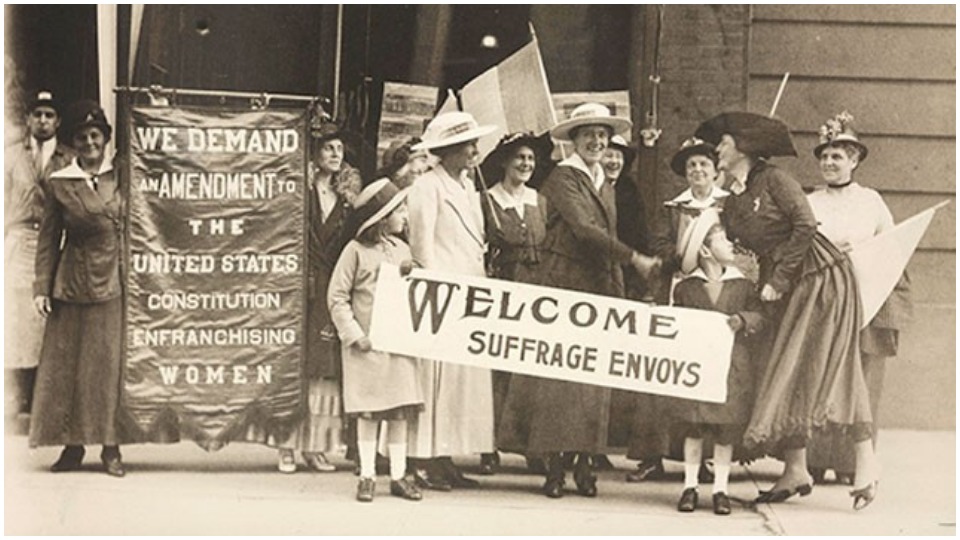
Although women had the right to vote in several states even before 1920, the 19th Amendment to the United States Constitution—ratified on August 18, 1920, by Tennessee, the last state needed to meet the three-fourths quota—allowed for universal women’s suffrage throughout the country starting with the presidential and other down-ticket elections that November.
As with just about everything in history, especially U.S. history, this statement comes with an asterisk. Our storied rights to “life, liberty, and the pursuit of happiness” have always been profoundly and essentially qualified according to many characteristics—birth, class, gender, race, immigrant status, land ownership, felony conviction, literacy, and a myriad of other factors.
The celebration of this centennial reminds us that the perfect society never was and never will be. Sometimes the pace of change takes on revolutionary proportions, though in the long perspective of history we often find that even revolution, once it has succeeded and life regains normalcy, never completely transforms human relationships and culture. Our historians—with a shout-out to the pioneering thinker Gerald Horne—are now looking at 1776 and questioning if the break from England wasn’t at its core an attempt to preserve slavery. The U.S. Civil War abolished slavery, yet conditions very similar to slavery persisted in many parts of the country—sharecropping, debt peonage, American “apartheid,” and the absence of civil rights and equality for most African Americans and not just in the South (and don’t forget that pernicious 13th Amendment!). This struggle continues still on many fronts—not to mention the original theft of the land from the Native inhabitants and the continued injustice flowing from the character of the European settler state.
1920. Last Sunday, I attended a birthday party in a local park for Mike, who had just turned 100 a couple of days before. 1920 was not all that long ago! If women achieved the vote in 1920, we must remember it was not all women, and not everywhere. Even that victory was, from today’s point of view, but a milestone along the way, not an end point. Without surveying the whole history of the woman’s suffrage movement, to which many books have been devoted, we know that going back into the 19th century the movement was fraught with division. There were women who opposed voting rights for Black males in the decades after the Civil War because the time had also come, they believed, for women’s right to vote. And among all the Black voices calling for their own voting rights, few also joined up with the women’s cause.
History is made in steps, some baby, some giant. There still remain many challenges to women’s representation. On the federal level, currently, the percentage of women in government leadership positions is just over 25% in the Senate, and just under 25% in the House. While these are the largest numbers in history, impediments remain—for younger women with families, for example, who do not enjoy paid maternity leave or affordable child care; unequal wages for women’s work; the entrenched sexism still in many quarters that discourages women from running for office in the first place; and the horrific woman-hatred that bedevils candidates and officeholders (she’s “shrill,” “nasty,” “persistent” and “ambitious,” she’s not “likable” and “ought to smile more,” and does she “bake cookies?”). Many other countries have higher women’s political participation rates than the United States, and in most of them (though not all) reproductive freedom and choice are more advanced than here—another impediment.

The fact that the Equal Rights Amendment has yet to be passed in the U.S. is little short of a global scandal. After all, in theory, at least, the international Declaration of Human Rights, drafted in part by our own former First Lady Eleanor Roosevelt in 1948, affirms gender equality.
At the current moment, the American women’s movement aiming to redress these imbalances has made huge advances as a bold partner in the anti-Trump rage. That anger translated, in 2018, into a new wave of progressive women running for the U.S. House, who overturned the GOP majority and in short order produced the president’s impeachment. The women’s vote will likely be the single most determinative factor in the November 3 elections this year.
These are remarkable, unprecedented times, now characterized by the historic role the Biden-Harris campaign is playing to elevate not only African-American concerns to the highest level of office, but women’s concerns as well. Despite the limitations of the 19th Amendment, which some perceived even at the time, there is no denying that it opened up the road to the incremental changes we have witnessed over the course of a century, including a 2016 popular vote majority for a woman vying for the presidency itself.
Was it revolution? No. Did it overthrow capitalism? No. Did it solve our tragic racial divide? No. But we cannot be deaf and blind to the hard-fought achievements we have scored in the ever pressing forward movement to expand and enhance our human rights and dignity.
As with all People’s World opinion articles, the views expressed here are those of the author.










